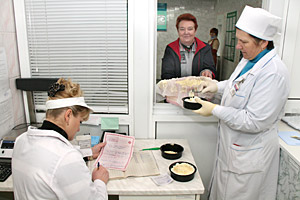The Komarovsky market food testing laboratory opens at 7 am. At this time traders wishing to have their products tested already queue here. Laid in straight rows on the table are rabbits and ducks, parked nearby are carts with pork and beef carcasses, waiting their turn for testing are boxes with cranberries and cottage cheese. The laboratory assistants are grating onions in the fruit and vegetable department. In order to determine nitrate contents they add a chemical reagent in the onion pulp and shake this mass in the magnetic stirrer. Then they drop two electrodes into the flask. A special device shows that there are 20 milligrams of NO3 per kilogram. This is a good parameter. In the next office the laboratory assistants are testing apples for radiation. They are placing small pieces of the fruit in a black plastic pot, Marinelli vessel. This vessel is placed in the radiology unit for 10 minutes.
“Products grown in the “A” areas – those regions of Belarus that are most affected by radioactive contamination -- are checked without any exceptions, and so are forest berries and mushrooms. The whole batch is stored in the laboratory until the examination is complete to make sure that no harmful food is sold in the market,” explains Ekaterina Dubikovskaya, head of the laboratory.
Honey testing is the most time-consuming procedure. The market security officers recently detained dodgers who sold fake honey made of sugar syrup, as the examination revealed.
“Honey cannot be liquid in November, it should be thick and crystallized by this time. See, when heated, the ‘honey’ became bluish after we added iodine. It means that this substance contains starch. This product is also examined for moisture and acidity. Acidity should fall within the range of 1 to 4. Also, the content of the diastase enzyme is determined. The higher the content of this enzyme, the more salubrious is the delicacy. All these parameters are specified in a card, which is issued after testing.
Meat delivered by private persons undergoes careful examination. For instance, to test the meat of a wild boar for trichinosis veterinaries make 96 very thin slices of the diaphragm which are then examined through a microscope. Horse meat is also tested for this disease, but a different technique is used. The meat is placed in a special apparatus that imitates the process of digestion. As for rabbits and poultry, only internal organs are explored. All meat is tested for radiation. When a veterinary has no doubts about the quality and safety of meat, it can be put on sale. An oval stamp on carcasses means that the examination has been carried out in full.











